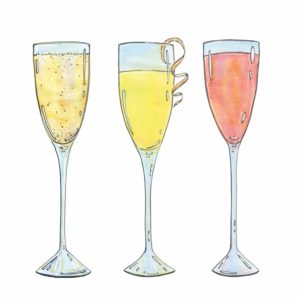 From Thanksgiving through New Year’s Eve (or Day for that matter), drinking Champagne really adds an extra dash of joy. The problem is many people are intimidated by it, seeing Champagne as something too fancy or unapproachable. Then there’s the cash. Spending upwards of $40 for a bottle isn’t something everyone will do — even if they are able.
From Thanksgiving through New Year’s Eve (or Day for that matter), drinking Champagne really adds an extra dash of joy. The problem is many people are intimidated by it, seeing Champagne as something too fancy or unapproachable. Then there’s the cash. Spending upwards of $40 for a bottle isn’t something everyone will do — even if they are able.
There are two ways to approach this problem. The first is to know that there are fantastic alternatives to Champagne (which only the sparkling wine from the Champagne region of France can be labeled). It’s worth some pre-festivities tasting to find a prosecco from Italy, cava from Spain, or sparkling wine from the U.S. that you like. There are many excellent possibilities that cost between $10 and $16 or so per bottle, and these wines are widely available. With these, perhaps it makes sense to get a few bottles to take you into the December holidays and New Year’s.
Once you’ve found a less expensive bottle that you are perfectly happy drinking as is, you can think about making cocktails with it. I’ve put together a few of my favorite drinks for which the base is a good, dry sparkling wine — what I’ll refer to here as “small c” champagne.
A useful and fun template is a combination of sparkling wine and flavored liqueurs, the Kir Royale being the most famous. Here’s the secret to doing these right: you want the liqueur to flavor the champagne but not to oversweeten it. Using a flute or coupe makes the drink appropriately festive. Chilling the glasses in the freezer makes it even better.
For each glass of champagne, use two teaspoons (1/4 ounce) of the liqueur. A 750-ml bottle of champagne will make about five 5-ounce drinks or four 6-ounce drinks. The procedure detailed for the Kir Royale works for all these variations.
Kir Royale: Pour 1/4 ounce Cassis or Framboise liqueur into chilled glass; fill with champagne; garnish with lemon peel.
Variation 1: Use orange-flavored, amber-colored Grand Marnier, and garnish with orange peel. (These were the choice at my house after coming home from Christmas Mass, though we had to make sure one certain uncle didn’t overdo it.)
Variation 2: Raspberry liqueur such as Chambord; garnish with raspberries.
Variation 3: Elderflower liqueur such as St. Germaine; garnish with a grind of nutmeg.
For that holiday brunch, the standard mimosa combines two ounces of orange juice with four ounces of wine, but use a gorgeous blood orange juice for a hint of drama. Or try one ounce O.J. and one ounce cranberry juice for what I like to call a Cape Cod Kir. All of these can be made by the pitcher for larger gatherings and ease of mixing. And all can be made with sparkling water as a lovely nonalcoholic alternative.
On this eve of the holiday season, I want to leave you with one that is a classic. The French 75 combines champagne with gin (although some cocktail sages opine that the original drink had brandy; that may be fine, but the gin version rocks). It always sets a festive tone. This is my preferred drink to have at the airport on the way to see family for the holidays.
The French 75
1 oz. gin (such as Hendrick’s or Tanqueray)
3/4 oz. simple syrup (made from equal parts sugar and water)
1/2 oz. fresh lemon juice
Sparkling wine
Rim a chilled flute with fine sugar; shake first three ingredients with ice and strain into the sugared flute. Fill with champagne and garnish with a lemon twist.
Wishing you the best for the holidays and of course that means please enjoy these drinks responsibly.



